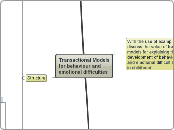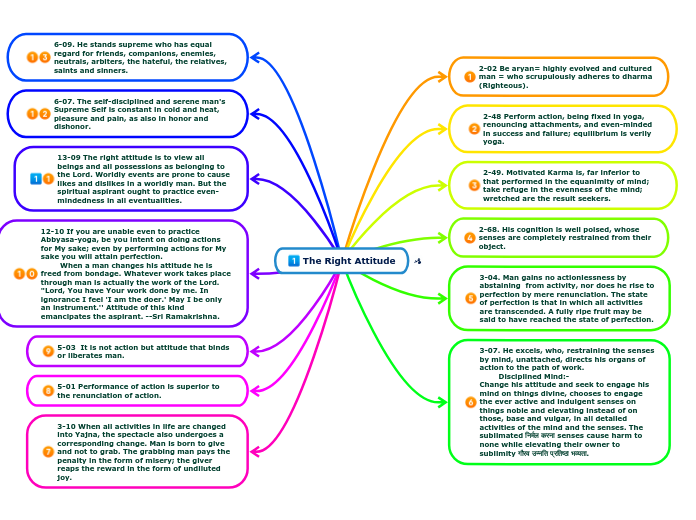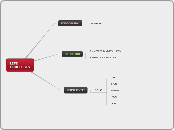Transactional Modelsfor behaviour and emotional difficulties
Structure
TM helpful
TM offer more levels of intervention
Main
Issues with models and measurement
pros for tm
Assotiation not causation
Section 6 in the Methods and Skills Handbook: ‘Measures of association’
Models
Section 10 in the Methods and Skills Handbook: ‘Modelling development’
TM in Emotional and Behavioural Difficulties
Problems with determining cause
Who is to blame - who should change - where to start intervention?
What about peers?
Medical problems: even medicalproblems can be "overcome"
p.85-86 highlights that other pathways e.g. language disorders are linked to behavioural problems
Problem: Causation as depenent on several factors
what kind of rules
who is asked
in what context
methodology: what questionnaires assesment methods are used
Book 2, Chapter 2: ‘Disturbed and Disturbing Behaviour’
TM in attachment and temperament
cons for TM
Sameroff, page 77TM gives no ethical guidance as to where to intervene and works "normative" on exising cultural codes and doesn't challenge them
Is giving ADHS to kis good or bad?
Just society?
Simplyfication: TM still focuses mostly on simple 2 way interaction while there is far more tr
(see p.85) have argued that other 'environmental' factors e.g. discord between parents, are more important
end chapt 5: ' cases where gross deprivation, neglect,distorted patterns of care or abuse create an adverse enviroment in which even the most resilient child develops disturbed patterns of adaptations.'
Does the concept of interaction help here?
Pros for TM
Evidence
Def: Attachment
Crockenburg (84
influence of social support on attachment
Murray
Depression
Depression and attachment (Greenberg et al., 1993; Sund and Wichstrom, 2002).(72)
Concept of Sensitivity
Murray (1992) found that 18-month-old infants whose mothers hadearlier suffered bouts of postnatal depression were much more likely to be assessed as ‘insecurely attached’ in the ‘Strange Situation’. This effect was particularly evident for the boys in the sample
Murray also found that the children of depressed mothers were more often reported to have temper tantrums, eating difficulties, to suffer sleep disturbance and to be overly clinging, suggesting the possibility that infant temperamentmay also be causing problems
Goldman and Alansky (b1, page 203)
Not all difficlut children will end up with insecure attachmen therefore ther must be TM
Book 2, Chapter 1: ‘Parenting and attachment’;
Def: Concept of Temperament
Thomas and Chess "difficult child" (b1, pag 192)
Book 1, Chapter 5: ‘Temperament and Development’, Section 6;
Introduction
Concept of transaction
def.
def. Sameroff
Transaction is more than reciprocity Sameroff (1987),
Reading A in the Methods and Skills Handbook: ‘The social context ofdevelopment’ (Sameroff)
even interaction is a difficult concept
General example of interaction Example PKU
Concept of Reciprocity
Goodness of fit
Nature versus Nurture
Examples
rather take example from temperament in Book 1?
It has also been found that parental perceptions of infant emotionality at 4 and 8 months infant age predict independent measures of infant emotionality at 8 and 12 months respectively (Pauli-Pott et al., 2003),b1 page 192
Attachment theroy
Traditionally much emphasis on role of mother or parants
Study Guide 2, Weeks 10 and 11.
other examples from forum
examples
effect of difficult child on maternal depression
Media Kit Part 2, Video Band 4: ‘First Relationships’;
Murray's research
in methods? or guide?
Crockenburg
where?
Explaining Behaviour
Explaining differences
Problem Behaviour
Cognition
Attachment
With the use of examples, discuss the value of transactional models for explaining the development of behaviour and emotional difficulties in childhood.
Materials
Book 1
Chapters x
Book 2
chapter 1
model of transactional behaviour
Chapters 2
pathways to negiative developement
Web
arcticle
http://www.acacamps.org/parents/expert/031112thurber6.php
open2.net
http://www.open2.net/childofourtime/2005/extractfour.html
Sameroff
Readings in Methodology book
Conclusion
"The interplay between risk and protective factors is not static. It needs to be understood within a developmental perspective in which children are susceptibleto different patterns of influence at different stages and transition points in life. For example, going to nursery or school is often an important gateway through which the ‘disturbed’ status of a troublesome child becomes confirmed. The particular demands, pressures and expectations for ‘good’ classroom behaviour (Klein and Ballantine, 1988) often amplify a child’s problems of social integration, because of the increased demands on the child to adapt."
B. Examples for transactional Models in emotional difficulties
Attitudes
MacKinnon-Lewis et al.
neg. attitude fuels negative behaviour P75
"For example, a large-scale Australian longitudinal study (Bor et al., 2003) found that mothers who had negative attitudes towards their infants at 6 months old were more likely to report behaviour problems when their children were 5 years old, especially for boys. The following example sheds further light on how this sort of process might be operating" (73)
Attachment (= behaviour +emotions)
Pathway to behaviour problems: Mother depression assotiated with insecure infant attachment -"Insecure attachment has been consistently linked with psychological difficulties (Greenberg et al., 1993; Sund and Wichstrom, 2002).(72)" but also are children of depressed mother more likeley to have adifficult temperament - who effects whom?
Difficult child "creates" Insecure attachment
goodness of fit =context specific
"In short, any particular ‘problems’ that a child might present need to be understood in terms of the demands of the context, the history of similar experiences faced by the child, and the history of the adult whofinds the child’s behaviour disturbing"
Chess and Thomas: "Goodness of fit (children temperament interacts with adult temperament)
"If a person’s characteristics of individuality match, or fit, thedemands of a particular social context then positive interactions andadjustment are expected"
Book 2 (64): "Difficulties arise when the behaviour and goals of the child lack ‘goodness of fit’ with the social environment to which the child is expected to adapt (Chess and Thomas, 1984)."
A. Examples of transactional Models for Behaviour
Dimensional Model of Transaction
However Simplification: "This is, of course, a gross oversimplification.Child ‘temperament’ and ‘environment’ are not single (but contextual), bipolar variables, nor are they static in time"
Environment
Adverse- Favourable
Child
Difficult - Easy
Gallagher (2002)
Goodness of fit is more than mere interaction
"Gallagher (2002) argues, joint effects of parenting and temperamentare not simply examples of organism–environment interaction;parenting is intrinsically bi-directional and reciprocal" (82).
Kochanska
"Kochanska (1995, 1997) highlighted how maternal behaviour and children’s temperament may intricately interact. She reported that fearful, inhibited children were more compliant when gentle low-power discipline was used whereas in fearless children the role of attachment was more significant in determining compliance. Whether a ‘difficult’ infant becomes a disturbed child appears to depend on the appropriateness of environmental adaptations to that temperament" (82)
Keogh
Effects of temperament on school
"temperamental influences will have more indirect effectson academic attainment. For example, reactivity is morelikely to influence pupil–teacher and pupil–pupil interaction and thereby the social context within which learning takes place" (199)
Selection of activitieswho in turn inhance exisiting temperament of the children
temperament selecting forsuitable environment whichfeedback on experience
Johnston et al. Direction of behaviour not monocausalpage 80
ADHS
In a second study Johnston et al. (2000) evaluated the short-term therapeutic potential of the drug Ritalin (Methylphenidate),
Mother's attitudes changedwhen children wre drugged
"Studies of the effects of drug therapy on mother–child interaction in children with attention deficit hyperactivity disorder (ADHD) illustrate the potential impact of child variables on the development of disturbed behaviour."
Model of a pathway to antisocial behaviour according to Patterson (1984)
"In this model, weak parenting skills are believed to encourage the child to become noncompliant to parental requests and to make unreasonable (coercive) demands on parents and othermembers of the family. The growing negative attention given to the child’s inappropriate behaviours combines with a failure to reward positive behaviours to produce an escalating cycle of parent–child conflict"
Malnourishment and Parental behaviour
Developing cognitive abilites or not
example in sameroff?
Introduction:
Nature vs. Nurture?
Systems Model: Feedback loop
No simple moncausal effects









